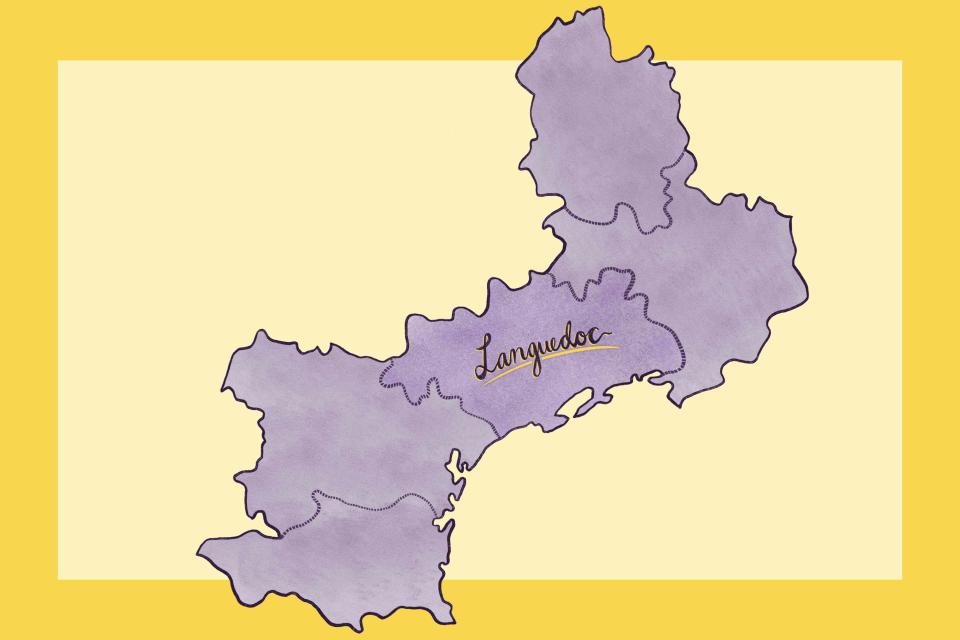Cinsault: Everything You Need to Know
If you love Châteauneuf-du-Pape or a crisp glass of rosé, Cinsault belongs on your radar.

Food & Wine / Sabrina Tan
Cinsault is one of those grape varieties whose impact tends to be far greater than its less-than-famous reputation might imply.
Its most well-known use is as a blending grape in the red wines of the Southern Rhône Valley and the Languedoc, as well as a component or sole variety for rosé. It also can be found in California (Lodi and Paso Robles are particularly notable), Australia (McLaren Vale and parts of Barossa), the Bekaa Valley of Lebanon, and the Western Cape of South Africa..
It’s also one of the parents of Pinotage (alongside Pinot Noir), historically the variety most closely associated with South Africa.
Where does Cinsault grow?
Cinsault is most commonly found in the Languedoc and the Southern Rhône Valley in France.
It is a blending grape of significant importance in both regions, as the lower tannins and lifted aromatics make Cinsault an excellent counterpart to generally richer and more powerful varieties like Syrah, Grenache, Mourvèdre, and Carignan.
In Châteauneuf-du-Pape, the most famous appellation of the Southern Rhône and home to some of the most highly regarded red blends in the world, Cinsault plays an important role alongside more well-known varieties. Cinsault generally achieves ripeness at a considerably lower sugar level than, say, Grenache or Mourvèdre, which helps to moderate the potential alcohol of a blended cuvée, explains Randall Grahm, the legendary vintner whose Bonny Doon wines introduced Rhône varieties to an entire generation of American wine lovers, and whose new project, The Language of Yes, explores these varieties in particularly profound ways. Cinsault also adds aromatic lift and helps to moderate the tannins of those other varieties.
“In red blends, Cinsault's role is kind of like squeezing a lemon on grilled meat or seafood,” explains Steven McAllister, beverage director of CookNSolo restaurant group and Zahav restaurant in Philadelphia. “It often enhances the overall balance and harmony of the wine, providing freshness and finesse. It adds a layer of complexity to the blend, contributing nuances of red berries, floral notes, and subtle spice.”
With particularly good drought resistance as well as heat tolerance, Cinsault is also an important variety given the realities of climate change.
Related: Châteauneuf-du-Pape — Everything You Need to Know
What does Cinsault taste like?
Cinsault boasts red berry and cherry notes, as well as hints of minerality and flowers that can run the gamut from roses to violets. It is generally relatively low in tannins and high in aromatic compounds, resulting in a wine that, according to Grahm, shares a fair bit of character with Pinot Noir.
“Neither Cinsault nor Pinot Noir are particularly rich in tannins or anthocyanins, thus producing wines of lighter body,” he explains. “If there is enough flavor intensity in the grape, this lighter body and color can be successfully parlayed into ‘elegance.’” As a red and as a rosé, whether on its own or in a blend, Cinsault has a real sense of finesse and energy.
Cinsault in rosé wines
Cinsault contributes to a number of excellent rosés. This makes sense given its relatively lower levels of tannins, lively red fruit, and aromatic lift, all of which tend to take center stage in the context of rosé. Gerard Bertrand’s Côte des Roses rosé is a lively example from the Languedoc in which the variety is blended with Grenache and Syrah. It’s also part of the blend in Bertrand’s Clos du Temple, a profoundly delicious, age-worthy rosé that is among the most expensive in the world.
The wonderfully complex 2022 Component Wine Co. Vin de Fleurs Rosé, which is produced entirely from biodynamic, single vineyard Cinsault grown in Provence by Fondugues Pradugues, is a fantastic example of how brilliantly the variety does on its own.
Michael Kennedy, president and founder of Fraîche Wine Group, of which Component is a part, notes, “Cinsault is so important to great rosés due to its natural high acidity, which translates into super fresh and tasty wines. It's also heat tolerant and produces really gorgeous floral notes, making it perfect for this style.”
Related: Languedoc Travel Guide: This Southern French Region Is a Must-Visit Wine and Seafood Destination
Cinsault as a varietal wine and in blends
Cinsault is most commonly seen in reds as part of a blend, but there are some terrific varietally labeled ones available, too. The 2022 Turley Bechtold Vineyard Cinsault is a great example, crafted from vines that were planted in 1886. The 2022 Cuvée Sinsó from The Language of Yes (the variety dominates the blend at 64%) is an aromatically complex wonder, full of raspberries and cherries, oregano, rose petals, and minerality throughout. And the Massaya Cinsault Rosé, from the Bekaa Valley of Lebanon, is a perennial winner.
What does Cinsault wine pair with?
Cinsault is a very food-friendly grape variety, and whether you’re pairing with a blend or a varietally labeled bottling, it has the ability to work wonders at the table. “On their own, Cinsault red wines complement lighter dishes such as grilled chicken, roasted vegetables, or seafood pasta,” explains McAllister. His wine list at Zahav includes the Massaya Cinsault Rosé and the Château Musar Rouge 2000, both icons of Lebanese winemaking. That red is an extraordinary example of how brilliantly the best Cinsault-inclusive blends work with food even as they mature. “In red blends, Cinsault can stand up to heartier fare like grilled lamb, beef stew, or mushroom risotto,” he adds. “Cinsault rosé wines are fantastic with salads, grilled fish, Mediterranean cuisine, or simply enjoyed as an aperitif on a sunny day. Overall, Cinsault's food-friendly character makes it a versatile choice for a wide range of culinary experiences.”
For more Food & Wine news, make sure to sign up for our newsletter!
Read the original article on Food & Wine.

